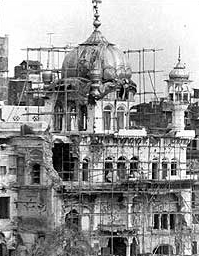This is an old revision of this page, as edited by NeilN (talk | contribs) at 15:35, 1 March 2015 (Reverted 1 edit by Sacha Sach (talk): NPOV. (TW)). The present address (URL) is a permanent link to this revision, which may differ significantly from the current revision.
Revision as of 15:35, 1 March 2015 by NeilN (talk | contribs) (Reverted 1 edit by Sacha Sach (talk): NPOV. (TW))(diff) ← Previous revision | Latest revision (diff) | Newer revision → (diff) Building in Amritsar, India| The Akal Takht ਅਕਾਲ ਤਖ਼ਤ ਸਾਹਿਬ | |
|---|---|
 The Akal Takht The Akal Takht | |
| General information | |
| Architectural style | Sikh architecture |
| Town or city | Amritsar |
| Country | |
The Akal Takht (Template:Lang-pa) meaning throne of the timeless one is one of five takhts (seats of power) of the Sikh religion. It is located in the Harmandir Sahib (Golden Temple) complex in Amritsar, Punjab, about 250 miles (400 km) northwest of New Delhi. The Akal Takht was built by Guru Hargobind as a place of justice and consideration of temporal issues; the highest seat of earthly authority of the Khalsa (the collective body of the Sikhs) and the place of the jathedar, the highest spokesman of the Sikhs.
History



The Akal Takht was built by the sixth Sikh guru, Guru Hargobind, as a symbol of political sovereignty and where spiritual and temporal concerns of the Sikh people could be addressed. A statue of Hargobind was erected at the site in 1606.
In the 18th century, Ahmed Shah Abdali and Massa Rangar led a series of attacks on the Akal Takht and Harmandir Sahib. Hari Singh Nalwa, a general of Ranjit Singh, the maharaja, decorated the Akhal Takht with gold. On 4 June 1984, the Akal Takht was damaged when the Indian Army stormed Sri Darbar Sahib during Operation Blue Star.
Design
The Akal Takht was built on a site where there existed only a high mound of earth across a wide open space. It was a place where Hargobind played as a child. The original takht was a simple platform, 3.5 metres (11 ft) high, on which Hargobind would sit in court to receive petitions and administer justice. He was surrounded by insignia of royalty such as the parasol and the flywhisk. Later, there was an open-air semi-circular structure built on marble pillars and a gilded interior section. There were also painted wall panels depicting Europeans.
The modern building is a five storey structure with marble inlay and a gold-leafed dome. Three of the stories were added by Ranjit Singh in the 1700s. Contemporary restoration work found a layer of paint decorated lime plaster that might have been part of the original structure but later than the time of Harminder.
Operation Blue Star
Main article: Operation Blue StarOn 6 June 1984, the Indian army made an assault on the Harminder Sahib in which the Akal Takht was damaged. The assault was ordered by Indira Gandhi who alleged Jarnail Singh Bhindranwale had stored weapons inside the complex.
Re-building
The Indian government began to rebuild the Akal Takht. Sikhs called the new structure the Sarkari Takht to indicate it had been built by the government and was not Akal (sacred).The Sikh home minister, Buta Singh, was excommunicated for his role in building the new Takht. He was returned to the church after penitence (cleaning the devotees's utensils and shoes at the Golden Temple). In 1986 the Sikh nation called the 'Sarbat Khalsa' (Sikh commonwealth) in which it declared Khalistan as the homeland of the Sikhs and also moved to rebuild Sri Akal Takht Sahib that had been repaired by the Indian Government. Funds provided by the Sikh nation were used for its re-building.
Khalistan
In 1986, Sikhs at Amritsar decided to tear down the sarkari takht and build a new Akal Takht through the Sikh tradition of Kar Seva and self-service. In 1995, a new, larger Takht was completed. One group declared a new sovereign Sikh state called Khalistan.
References
- ^ Fahlbusch E. (ed.) "The encyclopedia of Christianity." Eerdmans, Grand Rapids, Michigan, 2008. ISBN 978-0-8028-2417-2
- Sohan Lal Suri. 19th century. Umdat-ut-tawarikh, Daftar III, Part 2, trans. V.S. Suri, (1961) 2002, Amritsar: Guru Nanak Dev University, f. 260
- "Akāl Takht" Britannica website. Accessed 5 January 2013.
- "Around Harmandir Sahib" Shiromani Gurdwara Parbandhak Committee Accessed 5 January 2013
- "Buta" Rediff.com, March 1998.
- "Sarbat Khalsa Khalistan Declaration Of Independence 1986 Part 1" YouTube presentation.
Sources
- Harjinder Singh Dilgeer The Akal Takht, Sikh University Press, 1980.
- Harjinder Singh Dilgeer Sikh Twareekh Vich Akal Takht Sahib Da Role, Sikh University Press 2005.
- Harjinder Singh Dilgeer Akal Takht Sahib, concept and role, Sikh University Press 2005.
- Harjinder Singh Dilgeer Sikh Twareekh, Sikh University Press 2008.
- Mohinder Singh Josh Akal Takht Tay is da Jathedar 2005.
- Darshi A. R. The Gallant Defender
- Singh P. The Golden Temple. South Asia Books 1989. ISBN 978-962-7375-01-2.
- Singh K. (ed.) New insights into Sikh art. Marg Publications. 2003. ISBN 978-81-85026-60-2.
- Nomination of Sri Harimandir Sahib for inclusion on the UNESCO World Heritage List Vol.1 Nomination Dossier, India 2003.
- Macauliffe, M. A. The Sikh religion: Its gurus sacred writings and authors Low Price Publications, 1903. ISBN 978-81-7536-132-4.
External links
31°37′14″N 74°52′31″E / 31.62056°N 74.87528°E / 31.62056; 74.87528
Categories: